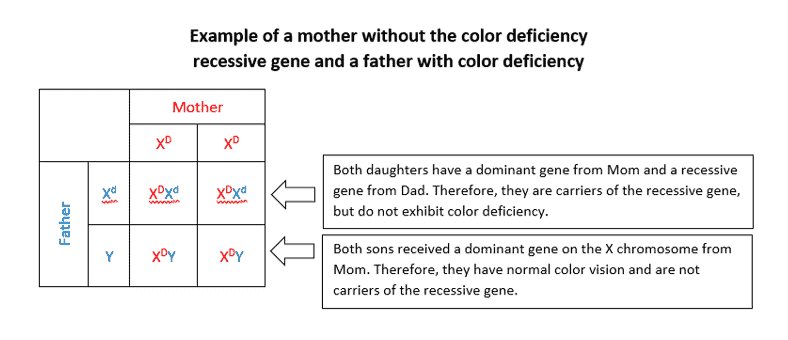
Color Vision Deficiency
May 29, 2020


Everybody knows a person who just cannot tell the difference between certain colors (and yes, men – we’re mostly talking about you here.) Truth be told, there is a scientific explanation as to why men are more likely to have problems with color vision. Remember drawing Punnett Squares in science class? Get ready for a refresher when you learn about the genetics behind color vision deficiencies!
Not “Colorblind”
The word “colorblind” is a poor term for someone who has cannot distinguishing certain colors. These people can see colors and are not truly color “blind”, but rather color vision deficient. Therefore, the term ‘color vision deficiency’ is a more appropriate and accurate diagnosis.
Color vision is derived from the photoreceptor cones in the retina. If there is an abnormality to the cone pigments or if an entire type of cone pigment is absent, then the person will have a color vision deficiency. The most common type is red-green color deficiency, which makes it difficult to tell the difference between certain shades of red and green. Blue-yellow color deficiency is another type, however, it is less common. There is a very rare condition, called achromatopsia, which only allows an individual to see in black, white, and shades of gray.
Causes of Color Vision Deficiency
The most common cause of color vision deficiency is genetic inheritance. When inherited, red and green colors are typically the problematic colors to differentiate. This is present during childhood and does not change or worsen over time. Color vision deficiency can also be acquired throughout life due to conditions that damage the optic nerve or retina. These conditions include glaucoma, diabetes, macular degeneration, malnutrition, and chronic alcoholism. Acquired color vision deficiencies usually involve difficulty with shades of blue and yellow.
Genetics 101
Color vision deficiency follows an X-linked recessive pattern of inheritance. Women have two X-chromosomes (XX), while men have one X-chromosome and one Y-chromosome (XY). If a man has the recessive color vision gene on their X-chromosome, they will be color deficient. If a woman has one recessive gene on the X-chromosome and one dominant (or normal) gene of the other X-chromosome, then the dominant gene will take over and the woman will have normal color vision. Therefore, men are more likely to be color deficient than women since they don’t have a backup X-chromosome.
In order for a woman to be color deficient, she must have two recessive genes – one from her mother and one from her father. All daughters of a color deficient man will be carriers of the recessive gene (see the Punnett Square example below). Punnett Squares can be used to determine any combination of normal/abnormal color vision inheritance. Capital superscripts represent a dominant gene and lowercase superscripts signify a recessive gene. Just substitute the color vision status of the mother and father to determine the possible scenarios for their offspring.

Diagnosing Color Vision Deficiency
A color vision test can detect a deficiency, however, it is also important to have a comprehensive eye exam to rule out any underlying pathology that could be contributing to decreased color vision. During a color vision test, a booklet of pseudoisochromatic plates are shown to the patient. Each page is comprised of colored circles and contain a different colored number among the circles. The results are based on the patient’s response to what number is seen or if a number is even visible at all. Some professions require a more in depth, detailed color vision test that involves arranging 15 or 100 hues in a particular order.
Treating Color Vision Deficiency
There is no cure for color vision deficiency. Some ophthalmic companies make specialized tinted glasses or contact lenses that can help a person differentiate colors by intentionally filtering out particular wavelengths of light. While these tools help a person see colors better than usual, they still cannot experience completely normal color vision. Since most cases of color vision deficiency are inherited, the person is able to adapt through childhood into adulthood. Kids can memorize that the red crayon has a name that starts with ‘R’ written on it. Adults remember the order or location of important colors, such as a traffic light. People with altered color vision live completely normal lives!